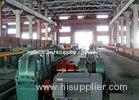Stainless Steel Tube Hydraulic Cold Drawing Machine For Non Ferrous Metal Pipe
Quick Detail:
Type: cold drawnbench
Brand name: Hengli
Model number: LW40
Input material: common carbon steel, alloy, nonferrous metal
After-sales service provided: overseas service available
Place of Origin: Jiangsu, China (Mainland)
Used in: the field of Carbon pipes, Non-ferrous metal pipes, and so on.
Description:
Introduction of the tube drawing process
When a hollow tube is drawn through a die, generally a mandrel or plug is used to support the inside diameter of the tube, this process is called tube drawing. The function of the plug is to effect wall reduction and to control the size of the hole. However, the mandrel may be omitted if it is not necessary to make a reduction in the wall thickness, or if the dimensions and surface of the inside are not important. The process to draw a pipe without any mandrel is known as tube sinking.
In drawing tubes over a stationary mandrel, the maximum practical sectional area reduction does not exceed 40 percent per pass the increased friction from the mandrel. If a carefully matched mandrel floats in the die throat of the die, it is possible to achieve a reduction in area of 45 percent, and for the same reduction the drawing loads are lower than for drawing with a fixed plug. This style is called the drawing with floating plug. To be mentioned is that in this style, tool design and lubrication can be very critical. Problems with friction in tube drawing are minimized in drawing with a long mandrel. The mandrel consists of along hard rod or wire that extends over the entire length of the tube and is drawn through the die with the tube. In this design, the area reduction can be 50 percent. However, after drawing, the mandrel must be removed from the tube by rolling (reeling), which increases the tube diameter slightly and disturbs the dimensional tolerances. The drawing process discussed above can be illustrated in the Fig. 1.

Fig. 1: Tube drawing processes. (a) sinking; (b) fixed plug; (c) floating plug; (d) moving mandrel A cold-draw bench for tubes consists of a heavy steel frame or bench, in the middle of which is located a die head for holding the die. At one end of the bench is located an adjustable holder to anchor the mandrel rod. At its other end a shaft is mounted carrying a sprocket wheel over which passes a heavy, endless, square-linked chain. This chain lies in a trough on top of the bench, which extends from the sprocket wheel to the die head, where the chain passes around an idler and returns underneath the bench to the sprocket wheel. The sprocket wheel is driven by a variable speed motor through suitable reduction gearing.
Production Operation
The hot-rolled tubes after cooling are pointed on one end. This pointing consists of reducing the outside diameter, for a distance of about 150 mm (6 inches), sufficiently to permit the reduced portion to enter the hole in the draw die freely, so that the jaws of the plyer can grip this end of the tube. If more than one cold-draw pass is to be given the tube, the point is made slightly under the final die size, if possible.
In most cases, one cold-draw pass is sufficient to reach close dimensions, good surface, and required mechanical property of the products. Additional passes may be necessary to secure: (1) thinner walls, (2) better surface finishes, (3) smaller diameters, or (4) longer length.
For production with multiple passes, it is necessary to anneal them after each cold drawing operation. Before further cold-drawing, the annealed tubes must be pickled and lubricated. All tubes, except unannealed mechanical tubes, receive a final anneal or heat treatment after the last cold-draw pass. Many tubes receive a special normalizing treatment before the last pass in order to obtain the proper grain structure in the finished tube; this annealing is performed in either continuous tunnel or car-bottom batch furnaces fired with gas. The continuous furnaces are provided with heat-resisting driven rolls used to carry the tubes through the furnace at a predetermined rate depending on the tube section, annealing temperature, time at temperature, etc. The car-bottom batch furnaces are arranged in a battery and are served by a special charging crane.
Further, the cold-drawn, annealed tubes are subjected to the finishing operation such as straightening, cutting, inspecting and testing.
Applications:
Specifications:
|
NO. |
Name |
Technical Parameters |
Unit |
|
1 |
Rated drawing force |
400000 |
N |
|
2 |
Max admitted diameter of work |
60 |
mm |
|
3 |
|








